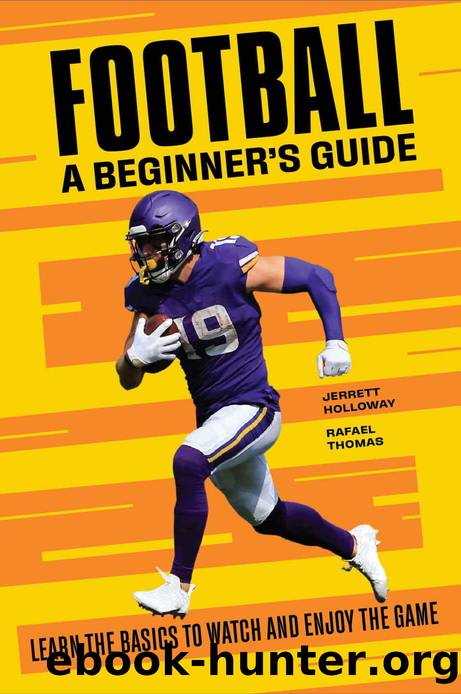Football a Beginner's Guide: Learn the Basics to Watch and Enjoy the Game by Jerrett Holloway & Rafael Thomas

Author:Jerrett Holloway & Rafael Thomas [Holloway, Jerrett & Thomas, Rafael]
Language: eng
Format: epub
Tags: Sports & Recreation, Football, Reference
ISBN: 9781638076780
Google: y9d3zgEACAAJ
Publisher: Rockridge Press
Published: 2022-05-10T07:10:10.382879+00:00
Run-pass option: In recent years the NFL has seen a return of the run-pass option offensive scheme to the game. When using a run-pass option (or RPO), the quarterback works with a running back in the backfield. After the snap, the quarterback will read how the defense is attacking the play and will react accordingly. If the defense is going after the running back, the quarterback will fake handing the ball to that player and keep it, running in the opposite direction as the running back. The quarterback will then also have an option to pass the ball to a receiver down the field as long as they do not run beyond the line of scrimmage before throwing (which applies to every pass thrown in a game). Although the run-pass option is a risky play to run too often because the quarterback is exposed to more tackles, hits, and potential injuries, itâs a good way for some teams to use the athletic ability of their quarterbacks and minimize the number of times they need to throw the ball during a game.
Catch vs. incomplete pass: One of the most often discussed topics during an NFL game is whether a player made a catch or not. In simple terms, a catch is when a receiver gains possession of a thrown ball, keeps both feet in bounds, and never lets the football touch the ground. Though it might seem very cut-and-dried, things can get complicated. For example, a wide receiver canât allow the ground to help them maintain possession of the football during a catch, nor can they allow the ground to shake the ball out of their possession before the catch is made (youâll hear the announcers say âthe ground canât cause a fumbleâ with some regularity). In both cases, that becomes an incomplete pass. The football can be held against a playerâs body, including their helmet or even between their legs, and still be considered a catch. It can even roll on the body of a defensive player on the ground before being picked up by an offensive player. If it doesnât touch the ground, it is a catch.
An incomplete pass can sometimes be just as difficult to determine as a catch itself. An incomplete pass happens when a receiver doesnât have or maintain possession of the football, or if they fail to establish both feet in bounds before falling or running out of bounds. An incomplete pass is also called if a defensive player makes contact with the receiver after the receiver touches the ball but is unable to gain possession of the football. This type of play can be mistakenly called a fumble on the field before the replay officials determine whether a receiver ever had possession of the pass before it was recovered by the defense for a turnover.
DOWNS, DISTANCE, YARDS, AND HOW IT SHAKES OUT
Here we quickly explain the simple terms of downs and distance, how an offense âgainsâ a first down, and what they are thinking
Download
This site does not store any files on its server. We only index and link to content provided by other sites. Please contact the content providers to delete copyright contents if any and email us, we'll remove relevant links or contents immediately.
Crazy Rich Asians by Kevin Kwan(9105)
Small Great Things by Jodi Picoult(6840)
Spare by Prince Harry The Duke of Sussex(4972)
Too Much and Not the Mood by Durga Chew-Bose(4212)
Machine Learning at Scale with H2O by Gregory Keys | David Whiting(3902)
Never by Ken Follett(3688)
Harry Potter 02 & The Chamber Of Secrets (Illustrated) by J.K. Rowling(3591)
I'll Give You the Sun by Jandy Nelson(3315)
The Ultimate Backcountry Survival Manual by Aram Von Benedikt; Editors of Outdoor Life;(3176)
Fairy Tale by Stephen King(3133)
The Man Who Died Twice by Richard Osman(2942)
Fantastic Beasts and Where to Find Them: Illustrated edition by J.K. Rowling & Newt Scamander(2938)
Reminders of Him: A Novel by Colleen Hoover(2845)
The One Memory of Flora Banks by Emily Barr(2738)
Will by Will Smith(2718)
Beautiful Disaster 01 by Jamie McGuire(2717)
Harry Potter and the Deathly Hallows (7) by J.K. Rowling(2598)
Photographic Guide to the Birds of Indonesia by Strange Morten;(2457)
Hooked: A Dark, Contemporary Romance (Never After Series) by Emily McIntire(2451)
